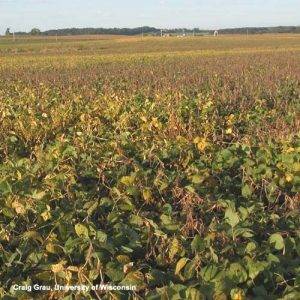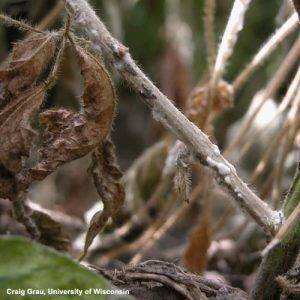Sclerotinia Stem Rot or “White Mold” in Soybeans
Sclerotinia stem rot – also known as White Mold –can lead to significant yield loss in soybeans. Yield loss from white mold is attributed to the damage it causes to leaves, pods and stems. Research from the University of Wisconsin estimates the disease has costed growers in the U.S. and Canada 101 million bushels of soybeans – equal to $1.2 billion.
White mold is caused by the fungus Sclerotinia sclerotiorum and overwinters in the soil for a number of years. After the fungus emerges from the soil, mushroom shaped structures known as apothecia will form on the soil surface. The apothecia, ranging between ¼ and ½ an inch wide, will first infect through soybean flowers before it reaches the stem.
While the fungus primarily spreads through the air via spores, moisture is required for infection to take place. As a result, cool and wet weather along with high humidity are the main causes of white mold.
Scouting for White Mold
While Sclerotinia sclerotiorum is often confused with other fungal pathogens, the sclerotia distinguishes white mold from other look-alike diseases. Symptoms of white mold will be most prevalent between R3 and R6. Infected plants will exhibit white fuzzy growth on the lower stem.
Soybean blossoms are the first area of the plant to exhibit signs of infection and neighboring stems and pods may appear water-saturated. After infecting blossoms and pods, white mold may eventually spread through the entire stem causing it to turn tan or bleached of color. As the mold growth becomes thicker, black spots will begin to surface throughout the fuzzy white surface.
White mold also creates foliar symptoms, causing leaves to completely die while still attached to the stem. In infected soybeans, the tissue area between the leaf veins will turn gray and cause leaves to become wilted and curled.
Treatment Options
Due to the overwintering nature of the sclerotia, a two to three-year rotation away from soybeans is advised. When it comes to genetics, some soybean varieties are more resistant to white mold than others. Varieties with resistance to the fungus may recover better than others. It is also important to consider planting practices that cause white mold growth. Shade created from high plant density and growing canopies can lead to the fungal disease. Increasing row width and reducing planting populations are the best methods to improve airflow through the canopy and reduce infection from white mold.
In addition, broadleaf weeds are notorious for hosting white mold and herbicides should be used to control weeds. Fungicides are a viable method for treating white mold and can reduce the negative impacts incurred by soybeans. However, they are most effective when applied just before infection takes place. Be sure to consult with your local Latham representative to determine the best treatment plan for white mold.

